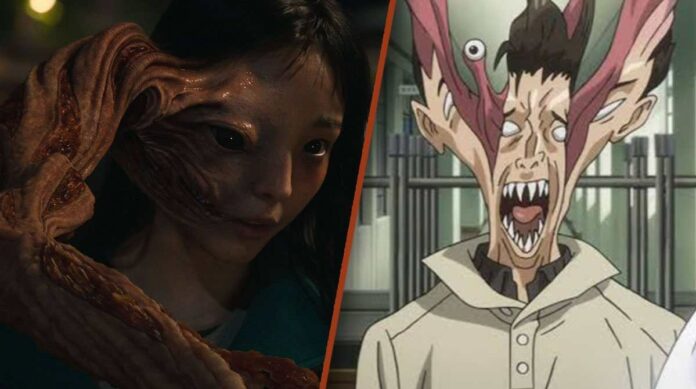Netflix Korean drama series, Parasyte: The Grey is an official adaptation of the Hitoshi Iwaaki’s manga series. Most people associate with this fandom because of the anime Parasyte: The Maxim, which aired in 2014. Many fans, like myself, were prepared to be disappointed by the Netflix adaptation, but then it surprised all of us and decided to come up with an original narrative instead. The plot in this live-action adaptation is based in South Korea and has its own characters. But quite obviously, there are parallels that the series draws as well. Moreover, the events of the Netflix’s Korean drama are set in the same universe as the anime. The events of the series may even run parallel to the events of the anime. In this article, we’ll be going through some of the differences that the Netflix adaptation has made from the anime.
Spoilers Ahead
Who Is The Protagonist?
The protagonist is Jeong Su-in, a young woman in her late 20s who works at a supermarket in Namil-gun. In the anime, the protagonist was Izumi Shinichi, a 17-year-old high schooler in Japan with whom the Parasite merges. The story in the series centers around Su-in’s misadventures when she gets infected by this Parasyte, who calls herself Hyde and later Heidi.
How Does The Protagonist Become A Mutant?
In the anime, Shinichi was listening to music with his earphones in when he got infected. Because of this, the Parasite larva wasn’t able to get into Shinichi’s head and had to merge with his hand instead. Because the Parasite consumed his right hand, they named themselves Migi, ‘Right’ in Japanese. In the series, while being pursued by a psychopathic man whom she ended up angering at her workplace, Su-in is infected by a Parasite larva. By the time the larva came across her, Su-in had been inflicted with multiple stab wounds and experienced blood loss. In an attempt to heal Su-in’s mortal wounds for their own survival, the Parasite fails to take over her mind and only partially merges with her. Because of this, Su-in retains her humanity and becomes a mutant.
While both Shinichi and Migi can stay conscious at the same time maintaining distinct identities, Su-in and Heidi cannot. Since Heidi merged with Su-in’s brain, the only way they can be in control is when Su-in is unconscious. In fact, Heidi can stay conscious at all times, but Su-in cannot when Heidi is in control. Operating from Shinichi’s right hand, Migi could detach themselves from his body as well. Heidi, on the other hand, cannot do that. Perhaps detaching themselves would even result in Su-in’s death. In mutant form, Heidi only morphs a part of Su-in’s face and uses a single tentacle for combat.
How Different Is The Story?
Parasyte: The Maxim is set in Japan and follows 17-year-old Shinichi Izumi’s story as he and Migi fight off the other Parasites. There are many reasons why the anime is such a critically acclaimed show. The anime, which spans around 24 episodes, delves into explicit details and even explores the biology of the Parasites and explores the strengths and weaknesses of the Parasites. In fact, the Parasites in the anime, if I’m not mistaken, were extremely overpowered and agile.
For Parasyte: The Grey, it’s too early to say how much detail they would go into; a six-episode season does not reveal much for now either. However, the Parasites were much easier to kill for humans in the series. Neither does the narrative introduce overpowered Parasites like Gotou. To be honest, Gotou was a real monster and was impossible to kill. Gotou’s body was home to four other Parasites as well, which made him the ultimate killing machine. The plot in the anime was based on the original manga and has an entirely different story. Unlike the anime, the series protagonist doesn’t have a love interest either. Though I’m sure many people would ship Kang-woo and Su-in, I don’t think that’s likely.
Moreover, the anime had a closed ending where the Parasites and humans strive for peace after the Parasites decide to live in secrecy without killing people after they realize that the humans are way too dangerous. The series, on the other hand, has different interpretations. The ending of the first season chronologically takes place after the events of the anime, as Shinichi makes a cameo as a journalist. This scene suggests that even after the peaceful end the story comes to in the anime, the Parasite-Human War was still ongoing elsewhere.
What About The Other Characters?
There are a ton of characters in both the anime and the series. Obviously, the anime explores much more complex characters, both human and Parasite. For example, one of my favorite characters in the series was Reiko Tamura. As a Parasite, Reiko was quite emotionless and cold, but as the story progresses, she ends up giving birth to a human child, after which she develops maternal instincts. To protect this child, she ends up sacrificing herself. I think Reiko Tamura inspired the character of Kyung-hee in the series, who was Kang-woo’s sister as a human until she was infected by a Parasite. Like Tamura, she is a cold and emotionless Parasite who then starts to experience emotions. However, her story is very different from Reiko Tamura’s.

